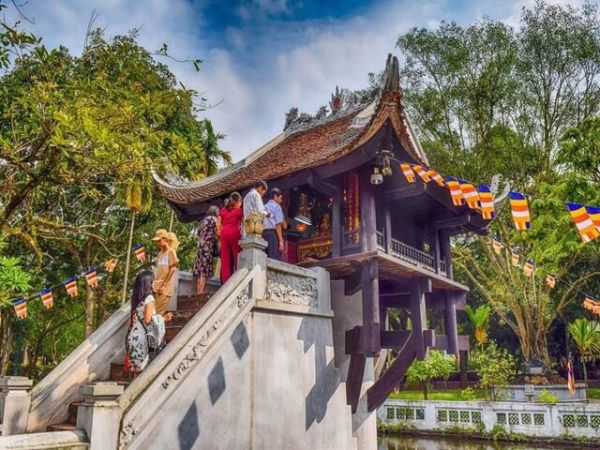ONE PILLAR PAGODA HANOI

One Pillar Pagoda Hanoi. It serves as a spiritual and cultural icon for Vietnam's capital, Hanoi. The temple's unique construction, as well as its historical significance, will undoubtedly impress visitors.
One Pillar Pagoda Hanoi Information:
Address: Chua Mot Cot Street, Doi Can Ward, Ba Dinh District, Hanoi City
The opening hours: From 7:00 AM - 5:00 PM.
The One Pillar Pagoda (formally known as Dien Huu Pagoda) is called from its unique architecture: the entire structure is built around a single pillar placed in the midst of a lotus pond. The site is in Ba Dinh District, a short walk from the Ho Chi Minh Complex, which includes Ba Dinh Square, the Ho Chi Minh Mausoleum, and the Ho Chi Minh Museum. The One Pillar Pagoda is thought to have existed since the Ly dynasty, indicating a significant growth of Buddhism in Vietnam. This monument is not just a popular tourist destination, but also a holy site for local pilgrims.
Without a doubt, One Pillar Pagoda is a must-see Hanoi tourism destination, frequented by both local and international visitors each year. According to renowned academics, this unique pagoda houses a variety of essential traditional Vietnamese values, and it guarantees to be a highlight of your Hanoi Shore Excursions.
How to get to One Pillar Pagoda Hanoi:
The One Pillar Pagoda is located on the park campus behind Ong Ich Khiem Street in Doi Can Ward, Ba Dinh District, Hanoi City. To the right of the pagoda is Ba Dinh Square, where grand parades take place on important Vietnamese festivals, and the Ho Chi Minh Mausoleum, the last resting place of our dear Uncle Ho.
If you have a motorcycle or a car, you proceed to the location of the Ho Chi Minh Museum and park in one of two places:
- Ong Ich Khiem Street
- Ngoc Ha Street
Adjacent to the Ho Chi Minh Museum.
If you prefer to ride the bus, several routes travel through Ba Dinh Square, including 09, 33, 22, 45, and 50, which stop at 18A Le Hong Phong.
This is the bus stop closest to the Mausoleum, therefore you may simply stroll to the One Pillar Pagoda area.
The History of One Pillar Pagoda Hanoi:
In the past, One-Pillar Pagoda was located in Thanh Bao Village, Quang Duc District in the west of Thang Long Citadel under the Ly Dynasty. According to Dai Viet Su Ky Toan Thu (A Complete History of Great Viet), the pagoda was built in the winter of 1049 under the reign of King Ly Thai Tong who dreamt of seeing the Goddess of Mercy sitting in a lotus throne and taking him to it. When waking up, the king told mandarins about his dream and one of them thought that it was a bad omen. Monk Thien Tue advised him to build a pagoda and a lotus-shaped tower like what he saw in his dream. When the pagoda was inaugurated, monks went around the pagoda and recited the Buddhist scriptures to pray for the longevity of the king. For this reason, the pagoda is also called Dien Huu (long-lasting happiness and good luck). When the pagoda was inaugurated, monks went around it reciting Buddhist texts to pray for the king's long life. For this reason, the pagoda is also known as Dien Huu (long-lasting happiness and good fortune).
According to researchers, Emperor Ly Thai Tong built the One Pillar Pagoda during the Ly dynasty, between 1028 and 1054. According to mythology, Emperor Ly Thai Tong had a dream in which Quan Am Bo Tat, a female Buddhist goddess, summoned him to a lotus seat. He decided to build a sacred sanctuary in the shape of a lotus flower after telling this story to a monk, Thien Tue.
Because of its capacity to blossom and spread fragrance despite emerging from a filthy environment, the lotus is regarded in Confucianism and Buddhism as a symbol of purity, wealth, and wisdom. One Pillar Pagoda is recognized as the Emperor's genuine gesture of gratitude to Quan Am Bo Tat.
During the conflict in 1954, the One Pillar Pagoda was destroyed by invading bombs. Following that, the government carried out a significant renovation using designs from the Nguyen Dynasty. Since then, the distinctive pagoda has been continually adorned and conserved as part of our country's cultural, historical, and architectural legacy. The pagoda hosted an annual celebration commemorating Buddha Day, also known as Vesak. In addition, on the eighth day of the fourth lunar month, the king and people went to the pagoda to partake in Buddha-bathing and releasing rites.
After many repairs, the pagoda was demolished by French colonists in 1954. In 1955, the government reconstructed the pagoda. The current wooden pagoda is square in design, with three meters on each side and a curving roof. It was supposed to mimic a lotus reaching up out of the square pond and was put atop a large stone pillar made up of two blocks that were masterfully joined together. This stone pillar is around 4 meters tall (excluding the subterranean part) and 1.2 meters in diameter. The pagoda construction also demonstrates a harmonic blend of imagination and distinctive design, with a system of wood beams that provide stability and beauty to the pagoda.
On April 28, 1962, the One-Pillar Pagoda was designated a historical relic because of its architectural and historical significance. On May 4, 2006, it was listed in the Vietnamese Guinness Book as the pagoda with the most distinctive architectural in Vietnam.
With its completely distinctive architecture, the temple was designated a National Historic Heritage in 1962 and became one of Hanoi's spectacular historic landmarks. After 50 years, in 2012, the Asian Records Association in India declared One Pillar Pagoda to be "the most unique architectural monument".

The unusual architecture of the One Pillar Pagoda in Hanoi:
Throughout history, the unique architectural characteristics of the One Pillar Pagoda have served as inspiration for several poems and essays. Its distinguishing qualities include the following.
One Pillar Pagoda has a unique architecture. The core structure is supported by eight wooden beams representing eight flower petals. When the architecture was built, all joints were exactly aligned, giving it an extremely strong structure. It is built on a massive stone pillar and depicts a lotus standing in the center of Linh Chieu Lake.
The pagoda's roof is covered in red brick scale tiles, and it has four curving corners. The masterfully carved "double dragon adoring the moon" stands out on the pagoda's roof, symbolizing harmony in the universe and protecting the pagoda's holiness.
One Pillar Pagoda may be described as a delicate blend of architecture, artwork, and stone sculpting.
Three-arched-entrance Gate - Tam Quan Gate:
The Three-arched-entrance Gate, also known as Tam Quan Gate, is located on the One Pillar Pagoda complex and has a horizontal painting of the three phrases "Dien Huu Pagoda." This gate was initially created many years ago, but it was recently restored to increase the scale of the One Pillar Pagoda, offering a space for monks and nuns to conduct religious activities while also welcoming tourists.
This beautiful gate is delicately positioned in front of the temple to replicate the traditional construction of a Vietnamese pagoda.
The stairs leading to the Main hall:
To reach Lien Hoa Dai's main hall, guests must climb 13 stairs measuring around 1.4 meters in width. These steps were constructed a long time ago and still bear the architecture of the Ly Dynasty.
The number 13 denotes fertility and wealth in Eastern culture, but it represents ill luck and tragedy in Western society. As a consequence, the 13 stairs represent the temple's benefits for pilgrims.
Lien Hoa Dai is the venue to worship Quan Am Bo Tat. The main hall has a massive altar with a gilded figure of Buddha sitting on a wooden lotus, surrounded by worshiping materials such as candles, flowers, fruits, and wine.
Another attraction of the One Pillar Pagoda is the Bodhi tree, which was gifted by President of India Rajendra Prasad during President Ho Chi Minh's 1958 visit to India.
With the spread of this tree, the relationship between these two countries grows stronger.

Tips For Visiting One Pillar Pagoda Hanoi:
The One Pillar Pagoda is a well-known example of Hanoi City's distinctive and famous architecture. This Buddhist cultural imprint is placed in the city center, making it quite accessible for visitors. Going to Hanoi without visiting this landmark would be a pity.
Vietnamese people who visit the One Pillar Pagoda will receive free entrance. However, foreigners would be charged 25,000 VND per person.
Because it is part of the Ho Chi Minh Mausoleum complex, the opening hours of One Pillar Pagoda vary depending on the rest of the region. Visitors can access this unusual temple between 7 a.m. and 6 p.m.
Unlike any other Buddhist pagoda, One Pillar Pagoda represents a profound humanistic perspective of life and the planet. Its splendor evokes ancient majesty while simultaneously concealing Buddhism's delicate and compassionate temperament. Hopefully, the information above has helped you decide where to go next on your journey.

Hotline/ WhatsApp: +847-6666-0606
Email: info@friendlytravel.vn













